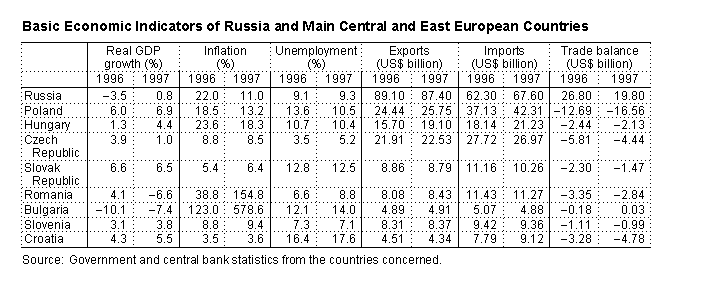
(2) Central and Eastern Europe and CIS
Japan External Trade Organization (JETRO)
[1] Trends in Trade
The recovery in the EU economy strengthened throughout 1997, and there are
signs that the economy will improve further going into 1998. The recovery is due
to not only strong foreign demand but also an upturn in capital investment and
private consumption, and domestic demand is gradually becoming the economic driving
force. According to the European Commission's 1998 Spring Economic Forecasts, the
improvement in economic conditions is set to continue, with the real GDP growth
rate of the 15 member states of the EU forecast to increase from 1.8% in 1996
to 2.7% in 1997 (estimate), 2.8% in 1998 and 3.0% in 1999. According to statistics issued by Eurostat, the EU's statistics bureau, on
the extra-regional trade of the EU's 15 countries, exports in 1997 totaled 718.4
billion ECU (European Currency Unit, 1 ECU = approx. \153) and imports were worth
668.2 billion ECU. The trade surplus increased for the sixth consecutive year
to 50.3 billion ECU. Both extra-regional exports and imports grew by 14.9% on
the previous year, which exceeded the 9.0% growth in extra-regional exports and
6.6% increase in imports posted in 1996. Intra-regional trade also grew a strong
8.1% on the previous year to 1.15 trillion ECU.
With regard to the enlargement of the EU, negotiations began at the end of March 1998 on admitting six new members: Poland, the Czech Republic, Hungary, Slovenia, Estonia and Cyprus. The EU is also seeking to strengthen its ties with other regional economic blocs. In London in April 1998, for example, the second Asia-Europe Meeting (ASEM) and the first EU-China summit were held, while at the EU-U.S. summit in May, the two sides agreed to a "Transatlantic Economic Partnership" (TEP) to ultimately eliminate trade barriers.
At present, the EU and 10 individual European countries are engaged in various campaigns to boost exports to Japan. These include "Gateway to Japan II," the EU's four-year campaign inaugurated in January 1997 and the second shot in its campaign to boost exports to Japan, and also the one-year "Festival U.K.98" and "French Year in Japan" launched in 1998.

Russia registered positive growth in 1997, although a slight 0.8%, for the first time in eight years, and with the rate of inflation falling further, there was a growing sense of economic stability. However, government revenues deteriorated rapidly from the fall in 1997 due to the effects of the Asian currency and economic crisis, and the economy has again assumed an appearance of instability. The economic condition in Russia is becoming increasingly severe in 1998. With regard to trade, key exports such as oil and natural gas were hit by the slump in international prices, and Russia's exports in 1997 fell 2.0% on the previous year and the trade surplus declined for the first time since 1992. The exports of the CIS fell in 1997 by 3%, while imports rose by 6%.
In July 1998, the West, including Japan, agreed to extend to Russia a $22.6 billion financial assistance package, including $15.1 billion from the IMF. Due to the impasse over the solvency of private banks and the redemption of short- and medium-term government bonds, however, the government and central bank were forced in August to effectively devalue the rouble and postpone repayment of debts to non-residents.
According to Russian statistics, the total value of trade between Japan and Russia in 1997 increased slightly by 0.8% to US$3.92 billion; Russian exports to Japan were up 0.7% on the previous year to US$2.94 billion, and imports from Japan rose by 0.9% to US$985.15 million. With then Prime Minister Hashimoto's declaration of the three principles of Russo-Japanese diplomacy in July 1997, dialogue between the leaders of the two countries progressed, and the two governments began economic cooperation under the "Hashimoto-Yeltsin Plan."
| Note: The term "Central and Eastern Europe" is here used to refer to the eight countries of Poland, Hungary, the Czech Republic, Slovakia, Romania, Bulgaria, Slovenia and Croatia. |
